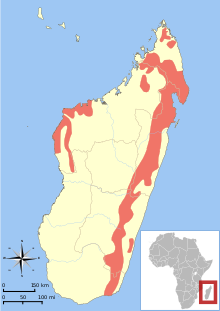Aye-aye
| Aye-aye | |
|---|---|
 |
|
| Scientific classification | |
| Kingdom: | Animalia |
| Phylum: | Chordata |
| Class: | Mammalia |
| Order: | Primates |
| Suborder: | Strepsirrhini |
| Superfamily: | Lemuroidea |
| Family: |
Daubentoniidae Gray, 1863 |
| Genus: |
Daubentonia É. Geoffroy, 1795 |
| Species: | D. madagascariensis |
| Binomial name | |
|
Daubentonia madagascariensis Gmelin, 1788 |
|
| Species | |
|
|
 |
|
| Distribution of Daubentonia madagascariensis | |
| Synonyms | |
|
Family:
Genus:
Species:
|
|
Family:
Genus:
Species:
The aye-aye (Daubentonia madagascariensis) is a lemur, a strepsirrhine primate native to Madagascar that combines rodent-like teeth that perpetually grow and a special thin middle finger.
It is the world's largest nocturnal primate, and is characterized by its unusual method of finding food; it taps on trees to find grubs, then gnaws holes in the wood using its forward slanting incisors to create a small hole in which it inserts its narrow middle finger to pull the grubs out. This foraging method is called percussive foraging which takes up 5-41% of foraging time. The only other animal species known to find food in this way is the striped possum. From an ecological point of view the aye-aye fills the niche of a woodpecker, as it is capable of penetrating wood to extract the invertebrates within.
The aye-aye is the only extant member of the genus Daubentonia and family Daubentoniidae. It is currently classified as Endangered by the IUCN; and a second species, Daubentonia robusta, appears to have become extinct at some point within the last 1000 years.
The genus Daubentonia was named after the French naturalist Louis-Jean-Marie Daubenton by his student, Étienne Geoffroy Saint-Hilaire, in 1795. Initially Geoffroy considering using the Greek name, Scolecophagus ("worm-eater") in reference to its eating habits, but he decided against it because he was uncertain about the aye-aye's habits and whether other related species might eventually be discovered. In 1863, British zoologist John Edward Gray coined the family name Daubentoniidae.
...
Wikipedia

